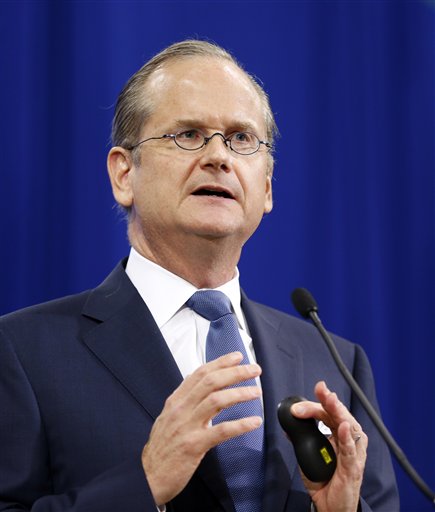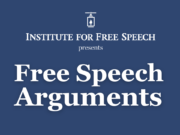Bob Bauer responded to my early summer post about professors Rick Hasen and Larry Lessig’s use of the infamous ‘Gilens and Page’ study. In familiar ‘pox-on-both-houses’ style, he avers it is a matter that “a particular evidentiary claim is overstated.”
Through understatement Bauer doubly flaws his analysis: “Noting that Rick Hasen and Larry Lessig had made use of the paper in arguing for a political equality theory of regulation, the CCP cited to critics of the scholarship and its conclusions.” Bauer expresses concern that this illustrates how adversaries of regulation such as CCP “get carried away in their rebuttals.” He expresses concern that as a result, “all hope for this discussion is lost.”
Stating Hasen and Lessig have “made use” of the study is like saying Donald Trump “makes use” of free media. Lessig cloaked himself in it like a favored sweater vest. He’s cited it in practically every talk, interview, and article since 2014. He launched his ill-fated Mayday PAC on its back; after Mayday PAC’s demise he revived it. In Ted Talks, presentations, op-eds, and his book the study was omnipresent. It showed how American democracy was like Communist China, Tammany Hall, and the segregated South. Hasen is a more careful scholar, but still promoted it in his book, talks, and articles.
And the scrutinizing researchers did more than “criticize the scholarship and it conclusions.” They exposed the study as flawed at best. The study featured a “flat line” graph that supposedly showed average Americans have zero independent policy influence. That line got Gilens and Page on The Daily Show. Lessig called the line “a metaphor for our democracy” and declared it “proved we don’t have a democracy anymore.”
Except the line was poppycock.
The data set was 1,779 bills. According to researchers, the rich and middle class disagreed on 185. The rich ‘won’ that subset 53%, the middle class 47% – instead of zero influence, the two classes were evenly matched. Another follow-up using different methodology concluded the same.
Gilens and Page responded using different criteria from their original study to massage the numbers in their favor. They did not, however, counter the basic criticism of their work as described in a Vox analysis: “The picture Gilens and Page painted of a world where the opinions of the middle class literally count for nothing doesn’t hold up.”
A blog and Twitter search reveals one tweet by either Professor Lessig or Hasen on the study’s debunking through May 23rd when Gilens and Page rebutted. Lessig is normally a prolific tweeter on current events, and Professor Hasen publishes, through his blog and listserve, a daily round up of news stories, editorials, and commentary relevant to campaign finance and election law. “Discussion” does not seem high on their agenda, at least not for academic critiques of a study each has cited extensively as evidence of the need for more regulation.
But does evidence even matter? Bauer suggests not “centrally,” because Hasen invokes “modern democratic norms of equal representation.” And anyway Buckley carelessly cited to a spotty record.
These are curious positions given Bauer’s social-science expertise and his calls for academics to buttress their work through them. For example, here is Bauer in the past:
The social science literature does not support him on [the thesis of his ‘referendum presidency’]; and neither do specific case studies.
Sunstein’s article appears around the same time that Seth Masket reports on evidence at odds with the belief that wealthy spenders reliably buy political outcomes. This is the latest social science tending to show that the linkage of wealth to political influence is a complicated question that does not find its answer in routine reform argument. . . The challenge for Cass Sunstein and others is to explain how this case can be put forward with evidence that matches up to the theory. (Emphasis added).
This is indeed the type of standard we’d expect from the Court when it considers allowing Congress to abridge core First Amendment liberties. Nor does Buckley’s cursory review of the Nixon Administration save the argument. The Court has performed searching inquiries in other First Amendment areas:
[W]hen the Government defends a regulation on speech as a means to redress past harms or prevent anticipated harms, it must do more than simply ‘posit the existence of the disease sought to be cured.’ . . . It must demonstrate that the recited harms are real, not merely conjectural, and that the regulation will in fact alleviate these harms in a direct and material way.
United States v. National Treasury Employees Union, 513 U.S. 454, 475 (1995) (quoting Turner Broad. Sys., Inc. v. FCC, 512 U.S. 622, 664 (1994) (plurality opinion of Kennedy, J.)) Cf. Lillian R. BeVier, Money and Politics: A Perspective on the First Amendment and Campaign Finance Reform, 73 Cal. L. Rev. 1045 (1985) (Unlike the doctrine emerging from the political contributions and expenditures cases, the Schenck-Brandenburg progression culminated in a highly speech-protective substantive rule of law. The rule assumes the primacy of first amendment values.)
The idea that if government can produce evidence beyond illusion there is “enough” to justify abridgments of First Amendment rights, if paired with “democratic norms,” seems directly contrary to the First Amendment itself. That Amendment aimed at protecting speech from transient “democratic norms.” The constitutional majesty of freedom of speech requires more than a “sense” contemporarily common. Proof of actual harm demands more than faulty records or flawed studies, it should be central.
If First Amendment evidence be so blithely shucked, Larry Tribe was surely wrong proclaiming free speech rights “the Constitution’s most majestic guarantee.”














